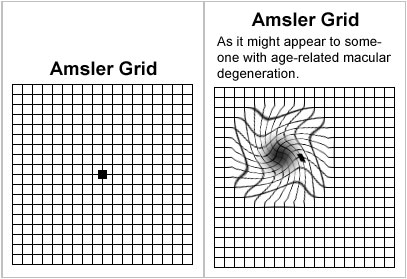 |
Age-Related Macular Degeneration (AMD)
|
 |
 |
 |
|
What is age-related macular degeneration (AMD)?
Age-related macular degeneration (AMD) is a disease that affects an individual's central vision. AMD is the most common cause of severe vision loss among people over 60. Because only the center of vision is affected, people rarely go blind from this disease. However, AMD can make it difficult of read, drive, or perform other daily activities that require fine, central vision.
AMD occurs when the macula, which is located in the center of the retina and provides us with sight in the center of our field of vision, begins to degenerate. With less of the macula working, central vision - which is necessary for driving, reading, recognizing faces, and performing close-up work - begins to deteriorate.
What are the different types of AMD?
There are two primary types of AMD:
|
|
|
 |
|
 |
|
|

|
Dry macular degeneration AMD
This type of AMD is the most common. While its cause is unknown, it occurs as the light sensitive cells in the macula slowly deteriorate, generally occurring in one eye at a time.
|
|

|
Wet macular degeneration AMD
This type of AMD is less common, but accounts for almost all severe vision loss caused by either type of AMD. Wet AMD occurs when new blood vessels behind the retina start to grow beneath the retina where they leak fluid and blood and can create a large blind spot in the center of the visual field. If this happens, there is a marked disturbance of vision in a short period of time.
|
|
|
 |
|
 |
|
|

|
blurry or fuzzy vision
|
|

|
difficulty recognizing familiar faces
|
|

|
straight lines, such as sentences on a page, telephone poles, and the sides of buildings, appear wavy
|
|

|
a dark or empty area (blind spot) appears in the center of vision
|
|

|
rapid loss of central vision - vision necessary for driving, reading, recognizing faces, and performing close-up work
|
|
|
 |
|
 |
|
|

|
Visual acuity test - the common eye chart test (see right), which measures vision ability at various distances.
|
|

|
Pupil dilation - the pupil is widened with eye drops to allow a close-up examination of the eye's retina.
|
|

|
Amsler grid - used to detect wet AMD, this diagnostic test uses a checkerboard-like grid (reduced size shown here; normal vision on the left and vision with AMD on the right) to determine if the straight lines in the pattern appear wavy or missing to the patient - both indications may signal the possibility of AMD.
|
|
|

|
|

|
Fluorescein angiography - used to detect wet AMD, this diagnostic test involves a special dye injected into a vein in the arm. Pictures are then taken as the dye passes through the blood vessels in the retina, helping the physician evaluate if the blood vessels are leaking and whether or not the leaking can be treated.
|
|
|
 |
|
 |
|
|

|
gender
According to some studies, women are at greater risk than men.
|
|

|
age
Although AMD can occur during middle age, the risk for developing the disease increases as a person ages. Studies have shown that while persons in their 50s have only a two percent risk of developing AMD, that rises to nearly 30 percent in persons over 75.
|
|

|
smoking
Recent studies have shown that smoking is a major risk factor for age-related macular degeneration.
|
|

|
family history
Persons with a family history of AMD may have a higher risk of developing AMD.
|
|

|
hypertension and cardiovascular disease
|
|

|
obesity
Studies have indicated that obesity may be linked to the progression of AMD.
|
|

|
high blood cholesterol levels
Persons with elevated blood cholesterol levels may be at higher risk for wet AMD.
|
|
|
 |
|
 |
|
|

|
your age, overall health, and medical history
|
|

|
extent of the disease
|
|

|
your tolerance for specific medications, procedures, or therapies
|
|

|
expectations for the course of the disease
|
|

|
your opinion or preference
|
|
|
|
|

